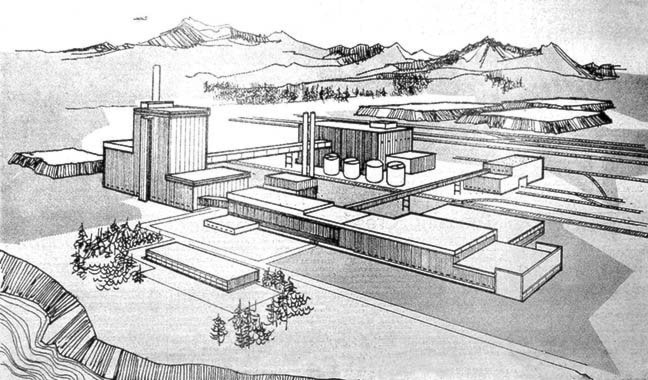Jim Cameron
"Like it or not, pulp mills smell and that's an economic fact of life," stated the Cranbrook Courier on March 9, 1966, under the headline, "Pulp Mill to be 90 Percent Odor-Free."
"All effluent materials toxic to fish will be rendered harmless before water goes back into the Kootenay River ... air and water pollution has always been a very real problem associated with these multi-million dollar babies."
Was it an indictment against the presence of a proposed pulp mill at Skookumchuk? Hardly. It was a statement of the facts with which the population would have to learn to live if they wanted one of those pulp mill "babies" to grow up in their neighbourhood.
It wasn't the first promise of a pulp mill in the area. In June, 1922, the local papers were rife with the claims that a mill or two were coming to the region. The ten million dollar "Wigwam Pulp and Paper Company, Ltd.," funded by the Chicago Daily Tribune, would establish a mill town near Elko, complete with a dam across the Elk River, or perhaps an English syndicate would construct a ten million dollar plant at Canal Flats. Didn't happen, of course, and when the 300 or so unemployed labourers who turned up in town looking for jobs finally wandered off, all was pretty much forgotten.
It wasn't until 1965 that the subject came up again, in the form of a public hearing of Canal Development's request for a Pulpwood Harvesting Area, the first step in the creation of a multi-million East Kootenay pulp mill near Canal Flats.
The company was a subsidiary of local lumber company Crestbrook Timber Ltd., and included the Honshu Paper Company and Mitsubishi (International) Corporation of Japan.
Curiously, at exactly the same time, Kicking Horse Forest Products proposed a mill near Golden and the Crows Nest Coal Co. proposed the same near Fernie.
B.C. Lands and Forests Minister Ray Williston chose to settle the matter by declaring a public auction for the 35 million cubic feet of timber made available for the purpose. Minister Williston set the auction date for August 2, 1965, and excitement grew in the various communities. It was all for naught as Williston called a halt to the auction part way through, "in the public interest," declaring that the bidding "had passed the limits of economic reality."
It appeared things were at an impasse when Canal Development declared it would proceed immediately with construction of a 70 million dollar mill without obtaining a pulp permit. Williston stated "the only reason for a Pulp Harvest Area is to secure the use of the pulp and thus enable the company to finance. If they are able to finance without a license then it has no particular significance ... if they are ready to go then they can go."
And go, they did, not at Canal Flats, however, but rather at Skookumchuk Prairie. It seemed that the Columbia Treaty would not allow drainage from the Columbia Lake into the Kootenay River.
"History is Made as East Kootenay Pulp Mill is Confirmed," declared the March 2, 1966, Courier.
Initial construction called for two stages over three years to create a mill producing 700-tons-per-day of pulp. It would utilize waste material from local mills and timber of the Crestbrook forests, more than seven million acres of which Crestbrook acquired from Minister Williston in August, 1966, with, surprisingly or otherwise, no auction necessary.
Approximately 400 workers were hired to build the mill, with a projected crew of 250 to operate it and 400-500 to harvest the timber. It was to be "90 percent odor-free" but, according to the word on the street, that other ten percent "sure smelled like money".
The remaining question was whether the Japanese government would okay their country's participation to the tune of more than 32 million dollars to acquire 48.2 percent of the shares. When the Japanese approval came through in January, 1967, Vic Brown, president of Crestbrook Timber was so elated that he predicted a future community of 6,000 people at Skookumchuk.
By March, 1967, Fabro Building and Supply Co. of Cranbrook was setting up an on-site construction camp and the Regional District of East Kootenay issued a four million dollar building permit to H.A. Simmons, engineering consultants from Vancouver, the largest permit ever issued in the East Kootenay.
June 24, saw a ceremony to mark the official start of construction attended by numerous dignitaries including B.C. Premier W.A.C. Bennett, who poured the concrete for the corner of the administration building and who also opened the Fort Steele Bridge and the Fort Steele Living History Park the same day.
During the pulp mill ceremony Fussso Yamaguchi, managing director of Mitsubishi Shoji Kaisha Ltd., stated that the Skookumchuk pulp mill will prove "there is no national boundary or any other impediment when people trust, understand and co-operate with one another." Premier Bennett declared that "Japan was closer to B.C. than Ottawa. There are great mountains between Ottawa and B.C. and nothing but a friendly Pacific lake between Japan and B.C." The president of Honshu Paper Manufacturing Co., Ltd., expressed the view that the mill would be "the start of a part of history which will extend 100 years into the future."
The first carloads of unbleached pulp rolled out in the final week of November, 1968. The mill was acquired by Tembec Inc., in 1999 and purchased by Paper Excellence Canada Holding Corp. in 2013, for 89 million dollars.
As for the smell of money, well, in this case it was not always pleasant. Despite being "90 percent odor-free" the remaining ten percent could be downright brutal when the weather was right. It remained that way for many years but has improved in recent times. It is still noticeable upon occasion, a reminder that some money has a distinct odor.
